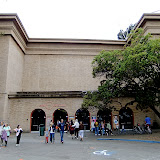 |
| Exploratorium |
One of the taglines of the place is, "where the right answer is a question" and it's obvious why this is so. The answer is in the name - Explore-atorium - and visitors are encouraged to let their curiosity reign and enjoy themselves. It is also described as a centre for 'science, art and human perception', so as not to pull apart these very interlinked disciplines and thereby create a holistic experience for all who come through the doors.
Let me start by talking about the staff, as this has been so far the clincher for each place. During the summer, the floors are filled with high school students, and these are the people showing visitors around. You may think this a risky strategy, and it is not without its problems, but it is a socially empowering and laudible one. It creates a learning environment, where if a student doesn't know the answer, they'll work together to find it. It's also showing too that it's OK for people to say, "I don't know", and foster the continuation, "but let's find out."
When school is in session, field trip explainers are the young adults who take over. These guys are there to try out teaching and continue this culture of curiosity. Ken Finn, my host at the Exploratorium, told us that part of the ethos was the feeling that you could become an expert in anything at all and as such the exhibits are designed to pique whichever parts of your interest you choose.
The place can be likened to a forest of phenomena, and it is possible to get overpowered by the potentials within. There are pathways for schoolchildren to find a specific set of interactives about a certain topic, but otherwise the aim of the place is in the name - the Explore-atorium. You can find anything from geometry you can climb on to seminal photography, all based in a warehouse with gothic stone angels watching over.
An important thing to note is that each exhibit is a prototype, designed to be played with, investigated and used. It may not look so 'pretty', but you are immediately hit with the great feeling as a visitor that you can touch the exhibits. It doesn't create as much of a barrier as you maybe get with the 'perfect' interactives in other museums.
They are designed by inventors, people with arts backgrounds, museum studies graduates - any number of people who've come in, started as volunteers and made their way into the workshops. Whilst previously it was a matter of having an idea and going for it, now there are a couple of extra funding layers to get through. However this doesn't stop someone from building a prototype and putting it forward.
One remark here - having the floors stacked with these handling-friendly prototypes means that a lot of things get well used and as such broken. This isn't a problem in the Exploratorium, because the designers are there to see how the public interacts with their ideas in the first place, and it is the whole design team's job to go around and repair whatever is broken outside. Everyone does everything - the ownership of the whole place is shared amongst those who work there and even the visitors themselves.
You may also think that the materials used are somewhat shabby in places as a result of all this handling and discovery. It is true that the centre has a good recycling scheme where people bring in old bits of wood, plastic and so forth and Ken freely admitted that this is because materials are expensive and you have to make do with what you have. There is a great spark of brilliance in looking at what you're given and being challenged to make something from it.
In fact the museum has created cookbooks, telling you how to make exhibits for centres and big schools and the lighter 'snackbooks' have since been written showing smaller scale versions for schools. There have as a result been festivals where schoolchildren have been invited in to get their hands on the workshop and exhibited their own interactives - more social empowerment and community engagement.
The centre has around 600,000 visitors per year, and ten times that amount for online traffic. The website is just like the facility itself, a maze of curiosity that still manages references once the exhibits themselves have finished on the floors, e.g. the science of skateboarding. One way that the hi-tech and low-tech are being linked, for instance, is a microscope in the building being given the functionality to be moved and focused from online.
And what of the exhibits themselves? Well, apart from being very well-handled and touchable, they are extremely simple. One that we saw was simply a black box with a hole in the outside - this demonstrated that dark is the absence of light, as the inside was completely white and yet this couldn't really be perceived through the hole. Another was simply a button labelled "Do not push this button" and a counter showing how many people had. See the pictures above for others.
In short, this has been the perfect place for me to end my trip around North America's science establishments, as it takes the very best of them all and puts it out in its own unique way, without pretention and in a very welcoming, fun way. I have to thank my host, Ken Finn, for taking the time to give me a backstage view of the place and the opportunity to ask all my questions.
An excellent experience, and well worth a visit from anyone in the science communication community.



No comments:
Post a Comment